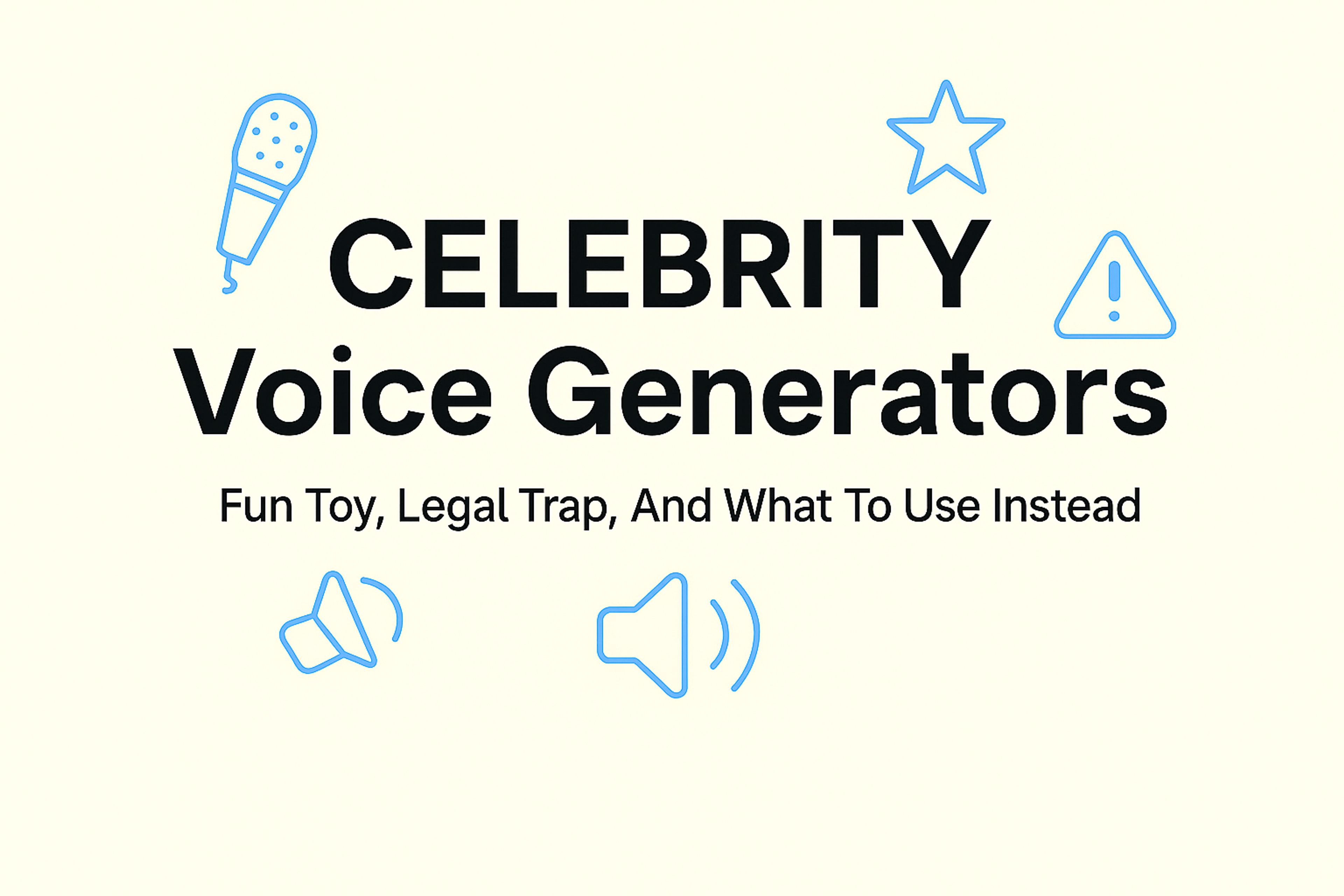Everyone’s seen it by now.
AI Trump arguing with AI MrBeast. Cartoon characters rapping drill. A dead-serious startup pitch narrated by an AI Morgan Freeman knockoff.
Celebrity voice generators went from “lol filter” to “should we use this in a real ad?” in about five minutes - and that’s exactly where creators, agencies, and brands start getting into trouble.
This is the straight-cut guide to celebrity voice generators in 2026:
- what they actually do,
- where they’re harmless fun,
- where they’re a legal and brand liability,
- and how serious operators should think about AI voices (spoiler: not by building their business on fake celebrity clones).
No fluff. No doom. Just how to not blow up your brand.
TL;DR: The Only Things You Need To Remember
- Celebrity voice generators are great for memes, private jokes, and sandbox experiments.
- Using sound-alike or cloned celebrity voices in real campaigns, paid content, or brand assets is a legal and reputational minefield.
- If you’re building a YouTube channel, course, product academy, or ad library you want to survive - use original, licensed, or platform-provided voices with clear terms.
- That’s the lane Listnr focuses on: production-grade voices that scale, instead of “AI [insert famous actor] for $0.03 a minute.”
If you only came for the answer: cute toy for fun, terrible foundation for a serious business.
What Celebrity Voice Generators Actually Are
“Celebrity voice generator” usually means one of three things:
- Parody text-to-speech apps
- You pick “President,” “billionaire founder,” “wizard headmaster,” etc.
- Type text, get a voice that sounds vaguely like the person.
- Mostly built for TikToks, Discords, and inside jokes.
- Voice cloning services
- Upload audio of a real person.
- Model learns their vocal fingerprint.
- You can now generate any line in their voice.
- Sound-alike libraries
- Voices “inspired by” certain archetypes: movie trailer guy, gritty detective, late-night host, suave narrator.
- Safer, because they’re not directly branded as a specific person, but still occasionally tread close to likeness.
The tech is impressive.
The incentives are messy.
The law is catching up faster than most creators think.
The Fun Side: When Celebrity Voices Are (Mostly) Fine
If you treat them like a party trick, you’re generally safe:
- Private memes with friends
- Internal jokes in your team Slack
- Non-monetized, clearly parodic content where it’s obvious it’s a spoof
Think of it like doing an impression at dinner.
Is there still nuance? Yes. But risk is low when:
- there’s no real revenue,
- no endorsement implied,
- no confusion that “this is actually the real person.”
The problem starts when people move this behavior into:
- ads,
- sponsorships,
- funnels,
- landing pages,
- brand content,
- political messaging.
That is where “lol generator” turns into “congratulations, you’ve impersonated a real human for profit.”
The Risk Side: Where Things Break Fast
If you’re a creator or brand operator, pay attention here.
1. Right of publicity and likeness
Using a celebrity’s recognizable voice (or a close enough imitation) to sell something, endorse a brand, or drive revenue can violate their publicity and likeness rights in many jurisdictions.
You do not need to say their name.
If it “sounds like them” and sells your thing, you are in the danger zone.
2. Copyright and training data
Many sketchy tools:
- never explain what data they trained on,
- do not clarify whether they have rights,
- hide behind vague “for entertainment only” disclaimers while users run full-blown ad campaigns.
If a platform cannot clearly state:
“Here’s how our voices are created. Here’s what you’re allowed to do commercially.”
you should not build anything serious on it.
3. Brand and trust damage
Even if you somehow dodge legal issues:
- fake celebrity endorsements look cheap,
- audiences smell “AI cringe” instantly,
- and clients do not want surprise demand letters because you used “AI David Attenborough” for their ESG video.
Short version:
What feels like a growth hack can nuke long-term trust.
What Serious Operators Should Use Instead
If you are running YouTube channels, courses, academies, UGC ads, or product content, you need:
- Original or licensed AI voices
- Clear commercial rights
- Consistency across hundreds of scripts
- Multi-language coverage
- Fast iteration and updates
That is the opposite of “celebrity roulette.”
This is the gap Listnr is built to fill.
How Listnr fits into this picture
- No unlicensed celebrity clones
The catalog is built for reliability, not cheap impressions. - Large, diverse voice library
Multiple accents, genders, tones, and styles so you can find a voice that fits your brand without stealing someone’s. - Control and scalability
Adjust speed, pitch, pauses, emphasis, and emotion so each module, ad, or script sounds intentional. - Enterprise-friendly usage
Designed for creators, agencies, and companies who need to know:
“Yes, I can use this in campaigns, courses, and paid content.”
Use celebrity-voice toys for what they are.
Use Listnr (or comparable compliant providers) when you want content that can live on your site and in your funnels for years.
How To Evaluate Any “Celebrity Voice Generator” In 30 Seconds
Before you touch it for anything public, run this checklist:
- Do they clearly say which voices are safe for commercial use?
If it’s buried or vague, walk away. - Are they trading directly on real names and likenesses?
“AI [famous actor]” as a paid feature is a giant red flag. - Is there documentation on training data and licensing?
If you get vibes instead of answers, treat it as a toy. - Would I be comfortable explaining this choice to a client’s lawyer or the actual celebrity?
If not, you already know. - If the tool vanished tomorrow, would my content be in trouble?
Never let a novelty tool sit at the core of your brand voice.
If a generator fails any of these, keep it in the meme folder, not your main stack.
A Smarter Setup: Fun On The Side, Serious In Production
Here is a practical model that does not get you sued:
- Use celebrity-style voices:
- for ephemeral, obviously comedic content,
- on non-commercial channels,
- labeled as parody.
- Use Listnr-style voices:
- for everything tied to money, clients, trust, or your long-term brand:
- course modules
- onboarding flows
- product explainers
- support videos
- faceless channels
- UGC ads and landing page videos
- for everything tied to money, clients, trust, or your long-term brand:
You still get the benefits of AI voices:
- speed,
- consistency,
- global reach,
- cost efficiency,
without stapling your future to a grey-zone impersonation tool.
FAQs: Celebrity Voice Generators (Straight Answers)
Are celebrity voice generators legal?
The technology is legal. Specific uses are not always. Imitating a real person’s voice to endorse products or mislead audiences can infringe their rights, depending on jurisdiction.
Can I use AI celebrity voices in YouTube videos I monetize?
High risk. Even if the platform does not catch it today, you are building on unstable ground. Avoid for brands, sponsors, or anything you want to scale.
What about parody?
Parody protections exist in some places, but they are narrow, context-specific, and not a free pass for ads or funnels. If you are leaning on “it’s parody” as your legal strategy, you are already too close to the line.
So what should I use instead?
Use AI voices designed and licensed for commercial work. Pick platforms that are explicit about usage rights, prioritize quality and control, and do not hinge on copying real people.

About Ananay Batra
Founder and CEO @ Listnr Inc
Ananay is the Founder & CEO of Listnr AI, he started Listnr with $100 in the bank back in 2020 and scaled it to 3mn+ users across 200 countries and $1.2m in revenue.
https://ananay.ai/